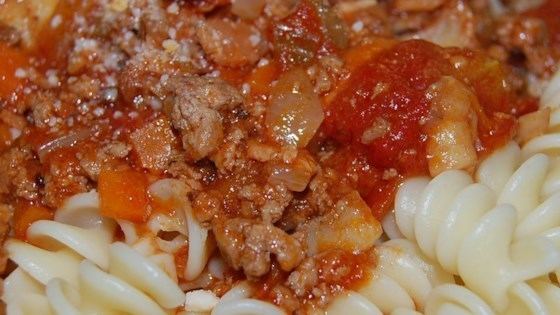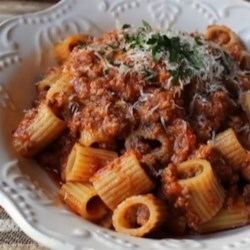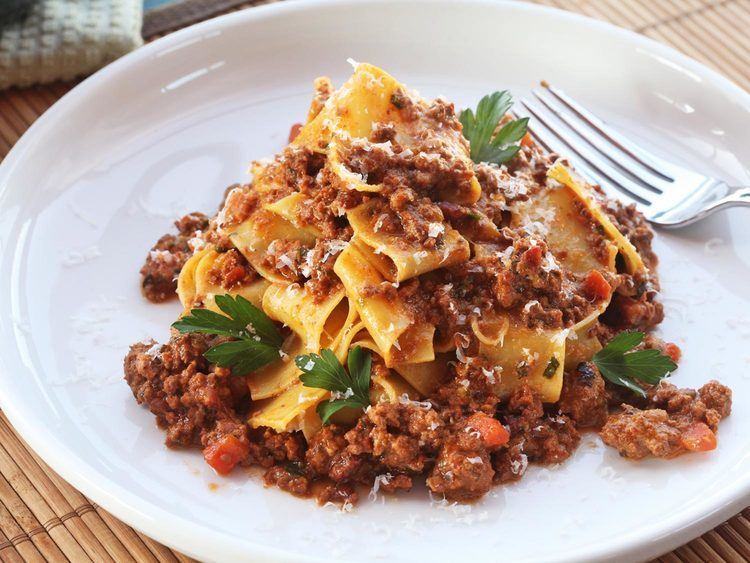Origin Italy | ||
 | ||
Main ingredients Similar Spaghetti, Lasagne, Carbonara, Béchamel sauce, Tomato sauce | ||
Bolognese sauce spaghetti sauce noreciperequired com
Bolognese sauce /bɒləˈnjeɪz/, known in Italian as ragù alla bolognese [raˈɡu alla boloɲˈɲeːze; -eːse], ragù bolognese [raˈɡu boloɲˈɲeːze; -eːse], or simply ragù, is a meat-based sauce originating from Bologna, Italy, hence the name. In Italian cuisine, it is customarily used to dress "tagliatelle al ragù" and to prepare "lasagne alla bolognese". In the absence of tagliatelle, it can also be used with other broad, flat pasta shapes, such as pappardelle or fettuccine. Genuine ragù alla bolognese is a slowly cooked sauce, and its preparation involves several techniques, including sweating, sautéing and braising. Ingredients include a characteristic soffritto of onion, celery and carrot, different types of minced or finely chopped beef, often alongside small amounts of fatty pork. Red wine and a small amount of tomato concentrate or tomatoes are added, and the dish is then gently simmered at length to produce a thick sauce.
Contents
- Bolognese sauce spaghetti sauce noreciperequired com
- Origin and history
- Evolution and variations
- Traditional service and use
- International Day of Italian Cuisines 2010
- Spaghetti bolognese
- References

The earliest documented recipe of an Italian meat-based sauce (ragù) served with pasta comes from late 18th century Imola, near Bologna. A recipe for a meat sauce for pasta that is specifically described as being "bolognese" appeared in Pellegrino Artusi's cookbook of 1891. The ragù alla bolognese that is now traditionally associated with tagliatelle and lasagne is somewhat different from Artusi's recipe. Many traditional variations currently exist. In 1982 the Italian Academy of Cuisine registered a recipe for authentic ragù alla bolognese with the Bologna Chamber of Commerce (incorporating some fresh pancetta and a little milk). In Italy, ragù alla bolognese is often referred to simply as ragù; and in Bologna, tagliatella.

Outside Italy, the phrase "Bolognese sauce" often refers to a tomato-based sauce to which mince (beef or pork) has been added; such sauces typically bear little resemblance to ragù alla bolognese. Whereas in Italy ragù is not used with spaghetti, so-called "spaghetti bolognese" has become a popular dish in many other parts of the world in spite of complaints against it one of the "crimes against ragù.

Origin and history

The earliest documented recipe for a meat-based sauce (ragù) served with pasta comes from late 18th century Imola, near Bologna. Pellegrino Artusi published a recipe for a meat sauce characterized as being bolognese in his cookbook published in 1891. Artusi's recipe, which he called Maccheroni alla bolognese, is thought to derive from the mid 19th century when he spent considerable time in Bologna (maccheroni being a generic term for pasta, both dried and fresh). The recipe only partially resembles the ragù alla bolognese that is traditionally associated with tagliatelle. The sauce called for predominantly lean veal filet along with pancetta, butter, onion, and carrot. The meats and vegetables were to be finely minced, cooked with butter until the meats browned, then covered and cooked with broth. Artusi commented that the taste could be made even more pleasant by adding small pieces of dried mushroom, a few slices of truffle, or chicken liver cooked with the meat and diced. As a final touch, he also suggested adding half a glass of cream to the sauce when it was completely done to make it taste even smoother. Artusi recommended serving this sauce with a medium size pasta ("horse teeth") made from durum wheat. The pasta was to be made fresh, cooked until it was firm, and then flavored with the sauce and Parmigiano cheese.
Evolution and variations
In the century-plus since Artusi recorded and subsequently published his recipe for Maccheroni alla bolognese, what is now ragù alla bolognese has evolved with the cuisine of the region. Most notable is the preferred choice of pasta, which today is widely recognized as fresh tagliatelle. Another reflection of the evolution of the cuisine over the past 150 years is the addition of tomato, either as a puree or as a concentrated paste, to the common mix of ingredients. Similarly, both wine and milk appear today in the list of ingredients in many of the contemporary recipes, and beef has mostly displaced veal as the dominant meat.
In 1982, the Italian Academy of Cuisine (Accademia Italiana della Cucina), an organization dedicated to preserving the culinary heritage of Italy, recorded and deposited a recipe for "classic Bolognese ragù" with the Bologna Chamber of Commerce (La Camera di Commercio di Bologna). A version of the academy's recipe for American kitchens was also published. The academy's recipe confines the ingredients to beef cut from the plate section (cartella di manzo), fresh unsmoked pancetta (pancetta di maiale distesa), onions, carrot, celery, passata (or tomato purée), meat broth, dry wine (red or white, not sparkling), milk, salt and pepper.
Nowadays, there are many variations of the recipe even among native Italian chefs, and the repertoire has been further broadened by some American chefs known for their expertise in Italian cuisine.
Ragù alla bolognese is a complex sauce which involves various cooking techniques, including sweating, sautéing and braising. As such, it lends itself well to interpretation and adaptation by professional chefs and home cooks alike. Common sources of differences include which meats to use (beef, pork or veal) and their relative quantities, the possible inclusion of either cured meats or offal, which fats are used in the sauté phases (rendered pork fat, butter, olive or vegetable oil), what form of tomato is employed (fresh, canned or paste), the makeup of the cooking liquids (wine, milk, tomato juices, or broth) and their specific sequence of addition.
The numerous variations among recipes for ragù alla bolognese have led many to search for the definitive, authentic recipe. Some have suggested the recipe registered by the Accademia Italiana della Cucina in 1982 as the "most authentic".
However, this would be inconsistent with the academy's own beliefs and statements about remaining faithful to tradition in documenting and preserving Italy's culinary heritage. Prominent Italian chef Mario Caramella stated, "In Italy, there are several traditional recipes of tagliatelle al ragù alla bolognese with more or less slight variations". According to UK cookbook author and food writer Felicity Cloake, "The fact is that there is no definitive recipe for a bolognese meat sauce, but to be worthy of the name, it should respect the traditions of the area", a view that is consistent with that often expressed by the Italian Academy of Cuisine.
The many variations tend to be based on a common theme. For instance, garlic is absent from all of the recipes referenced above, as are herbs other than a parsimonious use of bay leaves by some. Seasoning is limited to salt, pepper and the occasional pinch of nutmeg. In all of the recipes meats dominate as the principal ingredient, while tomatoes, in one form or another, are only an auxiliary ingredient.
Traditional service and use
In Bologna ragù alla bolognese is customarily paired and served with tagliatelle made with eggs and northern Italy’s soft wheat flour. Acceptable alternatives to fresh tagliatelle include other broad flat pasta shapes, such as pappardelle or fettuccine, and tube shapes, such as rigatoni and penne. While the main complaint of traditionalists is against the use of spaghetti rather than fresh tagliatelle for the pasta, native Bolognese Piero Valdiserra has argued that "spaghetti could be considered traditional in Bologna", even though tagliatelle is the "most suitable" pasta.
Ragù alla bolognese along with béchamel is also used by many Italian chefs to prepare traditional baked lasagna in Bolognese style.
International Day of Italian Cuisines 2010
Gruppo Virtuale Cuochi Italiani (GVCI), an international organization and network of culinary professionals dedicated to authentic Italian cuisine, annually organizes and promotes an "International Day of Italian Cuisines" (IDIC). In 2010 tagliatelle al ragu alla bolognese was the official dish for IDIC. The event, held on 17 January 2010, included participation by 450 professional chefs in 50 countries who prepared the signature dish according to "an authentic" recipe provided by chef Mario Caramella. Media coverage was broad internationally, but reports often incorrectly identified the recipe followed as that of l'Accademia Italiana della Cucina, and some included stock photographs of spaghetti Bolognese.
Spaghetti bolognese
Spaghetti bolognese (sometimes called spaghetti alla bolognese, or colloquially spag bol or just spaghetti) is a pasta dish consisting of spaghetti served with a sauce made from tomatoes and ground beef. It is often characterized by having a much larger proportion of sauce to spaghetti than is common in Italian spaghetti dishes, and the sauce is often laid on top of the spaghetti (rather than being mixed into it, as per Italian custom) or even served separately from it (so that the eater can mix to his or her own preference). It is often served with grated parmesan on top. The sauce is commonly referred to as bolognese sauce or just spaghetti sauce, but bears only passing resemblance to ragù alla bolognese.
While spaghetti Bolognese is mostly unheard of in Italy itself, it is a very popular dish in Northern and Western parts of Europe, as well as in North America, Australia and New Zealand. The origins of the dish are unclear, but it may have started as a simplified version of the ragù alla bolognese, and probably evolved in the UK or United States as part of fusion between Italian and local cuisine as in the aftermath of extensive Italian immigration to these countries in the early and mid-20th century. Bolognese sauce often also forms the basis of lasagna in the countries where it is common, just as ragù is used in the lasagna in Italy.
